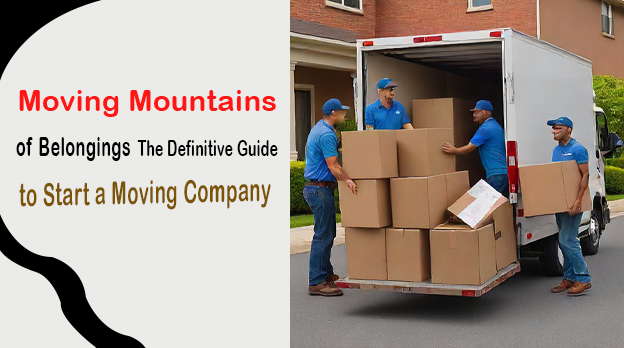Moving: a single word that can evoke a whirlwind of emotions. The thrill of new beginnings, the bittersweet pangs of leaving a familiar place, and inevitably, the daunting awareness of the logistical avalanche that comes with relocating your entire life. Amidst the inevitable stress of packing, planning, and paperwork, choosing the right moving company shouldn’t add to your burden. Instead, this decision should be viewed as forging a crucial partnership, one that can dramatically impact the ease and success of your entire transition. Whether you’re shifting across the city or embarking on a cross-country adventure, this comprehensive guide will empower you to confidently navigate the world of moving companies. We’ll equip you with the knowledge, strategies, and essential questions to effectively compare your options and confidently select a company that aligns with your unique needs, priorities, and budget How to Compare Moving Companies.
Phase 1: Casting a Wide Net: Locating Potential Moving Companies USA
Before diving into the nuanced details of comparing estimates and evaluating insurance policies, begin with a strategic approach to building a robust list of potential moving companies. Expanding your search initially allows for a greater selection and minimizes the risk of overlooking potentially perfect matches.
- Tapping into the Powerhouse of Personal Recommendations
Never underestimate the value of firsthand experiences and trusted referrals. Reach out to friends, family members, colleagues, neighbors, and even casual acquaintances who have recently navigated the moving process. Their personal anecdotes can offer invaluable insights that go beyond online reviews. Were they impressed with the company’s communication, punctuality, and professionalism? Did the movers treat their belongings with respect and care? Were there any hidden fees or logistical hiccups that caused frustration? Gathering these anecdotal insights can quickly highlight reputable companies known for their reliability while simultaneously alerting you to potential red flags.
- Unearthing Invaluable Information from Online Resources:
In this digital age, the internet is a treasure trove of customer feedback, providing valuable glimpses into the experiences of those who have gone before you. Diligently explore reputable review platforms like Yelp, Google My Business, and Trustpilot. Don’t just focus on the star ratings; delve deeper into the written content. Analyze the language used, look for recurring themes (positive or negative), and assess how the company responds to critical reviews. A proactive and professional approach to addressing customer concerns speaks volumes about their commitment to service.

Beyond general review sites, tap into platforms specific to the moving industry. The British Association of Removers (BAR), for instance, provides lists of accredited moving companies that have met specific standards and criteria for membership. Websites like ‘Which? Trusted Traders’ also offer independently verified reviews for a range of services, including movers. How to Compare Moving Companies.
Your search engine is a powerful tool for pinpointing potential movers who fit your specific criteria. Craft precise search phrases to refine your results and minimize time spent sifting through irrelevant options. Use geographically targeted terms like “best piano movers in [your city],” “long-distance removalists near me specializing in antique handling,” or “reputable eco-friendly moving companies serving [your region].” This strategic approach can lead you directly to movers with specialized expertise.
Phase 2: Zeroing In—Screening Potential Moving Companies USA with Targeted Questions
Armed with your initial list of prospective movers, it’s time to move from passive research to active inquiry. This stage focuses on gathering essential information through targeted questions, allowing you to filter companies based on crucial factors like licensing, services offered, and service areas.
- Verifying Licenses, Credentials, and Insurance Coverage: Prioritizing Peace of Mind:
Legitimate and reputable moving companies will be fully transparent and forthcoming with proof of licensing and insurance. In the UK, they confirm their registration with respected industry bodies like the British Association of Removers (BAR) or the National Guild of Removers and Storers. These organizations have codes of practice and often require members to adhere to specific service standards, offering an extra layer of reassurance. Request a copy of their insurance policies and review coverage limits, clarifying what’s included, what’s excluded, and their procedure for handling potential damage or loss claims. How to Compare Moving Companies.
- Clarifying the Spectrum of Services Offered: Ensuring They Align with Your Unique Needs:
Moving scenarios are rarely one-size-fits-all. Some relocations require comprehensive support, encompassing packing, provision of packing materials, furniture disassembly and reassembly, secure storage options, and specialized expertise for handling delicate or high-value items like artwork and pianos. Other moves may be simpler, involving the transportation of pre-packed boxes. During this phase, diligently inquire about each company’s complete range of services. Can they accommodate your specific requirements, or will you need to make additional arrangements?
- Confirming operational areas and potential partnerships for seamless long-distance Moves:
While it seems self-evident, always double-check that the moving companies you’re considering operate in both your current and destination locations. This is especially important for long-distance relocations. If your move involves traversing different regions or crossing country borders, ask about the company’s network and whether they have established partnerships with reliable movers in those areas. Smooth, synchronized handoffs between moving teams can significantly impact the efficiency and peace of mind of a long-distance move.

Reputable movers should willingly offer free, no-obligation quotes tailored to your specific moving details. However, exercise caution with companies reluctant to provide upfront estimates or those whose initial quotes seem significantly lower than their competitors. Unreasonably low prices may indicate potential compromises in service, hidden fees tucked away in the fine print, or a lack of adequate insurance coverage—all factors that could lead to costly surprises later.
Never hesitate to delve into the details of a company’s payment structure and cancellation policies. What forms of payment do they accept? Is a deposit required to secure your booking, and what are the terms of a refund if you need to cancel or reschedule? Ask about their billing procedures, potential fees for specific situations (long carries, stair charges), and when final payments are expected. Openly discussing these details upfront helps prevent misunderstandings or financial surprises down the line.
Phase 3: Going Deeper: A Comparative Evaluation of Key Differentiators in Moving Companies USA
Having narrowed down your list based on the initial screening process, it’s time for a more nuanced comparison. This phase focuses on evaluating factors that go beyond the basic services, delving into aspects that truly distinguish an exceptional moving company from one that’s merely adequate.
- Reading Between the Lines: Unveiling Insights from Customer Reviews and Feedback:
While star ratings on review platforms offer a quick glimpse into customer sentiment, a company’s true colors emerge when you take the time to carefully read the actual reviews, both positive and negative. Look for patterns and recurring themes. Are there frequent mentions of punctuality, professionalism, and respect for belongings? Do reviewers consistently highlight excellent communication or a willingness to go the extra mile? Equally telling is how—or if—the company responds to negative feedback. Proactive and solution-oriented responses suggest a commitment to customer service.
- Gauging the Effectiveness of Communication: A Key Ingredient in a Smooth Transition:
Seamless relocation experiences hinge on clear, prompt, and proactive communication throughout every stage. From the initial inquiry through to the final delivery of your belongings, assess how effectively each company communicates with you. Are they readily available through your preferred channels (phone, email, online chat) during business hours (and ideally, slightly beyond)? Do they promptly respond to questions or address concerns thoroughly and respectfully? Pay close attention to these nuances as they offer valuable insight into the company’s commitment to customer care.
- Examining the Nuances of Insurance Policies: Protecting Your Belongings
Moving always involves inherent risk, making adequate insurance coverage non-negotiable. Request detailed explanations of each company’s insurance policies and carefully compare their offerings. What are the coverage limits, and are they sufficient for the value of your belongings? Clarify exactly what situations and items are covered, what’s excluded, and whether additional insurance is available for specialized or high-value possessions. Understanding their claims processing procedure, including required documentation, response times, and the potential for disputes, can also save headaches should the unexpected occur.

- Seeking Flexibility and Personalized Solutions: Accommodating Life’s Unpredictability
Every relocation has its own unique set of demands and unexpected challenges. Assess each company’s willingness to accommodate your specific requirements and potential logistical constraints. Do they have a track record of being flexible with scheduling changes, navigating challenging access points (narrow stairwells, limited parking, multiple flights of stairs), or offering customized solutions for delicate, antique, or bulky items? The hallmarks of a genuinely customer-centric moving company are adaptability, problem-solving expertise, and a commitment to working with you—not against you—throughout the entire moving journey.
- The Importance of Experience and Expertise: Weighing Track Record and Specialization:
While there’s always space for new businesses, a moving company’s experience can bring an extra layer of reassurance. Inquire about how long they’ve been in operation and the types of moves they specialize in. Have they successfully executed many moves similar in scale, scope, and distance to yours? Experienced companies bring accumulated knowledge, streamlined logistics, and often, an ability to anticipate and address potential issues more effectively.
- Sustainability: Factoring Environmental Impact into Your Decision:
For eco-conscious individuals, a moving company’s commitment to sustainability may be a crucial deciding factor. Explore each company’s environmental policies and practices. Do they prioritize fuel-efficient vehicles or optimize routes to minimize fuel consumption? Do they utilize eco-friendly packing materials made from recycled or biodegradable materials? Do they offer carbon offset programs or opportunities for recycling unwanted items to minimize your relocation’s environmental footprint?
Phase 3: Going Deeper – A Comparative Evaluation of Key Differentiators in Moving Companies, USA
Securing detailed moving quotes from multiple companies is essential, but it’s only truly valuable when those quotes are based on comparable services and estimations. Your goal is not simply to find the lowest price tag but to identify the company offering the best overall value aligned with your needs and budget. A significantly lower estimate often indicates corners are being cut somewhere, potentially leaving you vulnerable to inadequate service or hidden fees down the line.
- In-Home Survey: A Crucial Step for Accurate Cost Assessment:
Avoid relying solely on online calculators or phone estimations, as they tend to be general overviews. Request an in-person, on-site survey conducted by an experienced company representative. During this assessment, they’ll physically evaluate the volume of your possessions, the potential logistical complexities of your property (elevator access, parking availability, narrow hallways, number of stairs), and any specific requirements for specialized equipment. This crucial step ensures that your quotes are tailored to your unique situation, resulting in greater accuracy and less chance of unexpected cost overruns later.
- Crafting a Comprehensive Inventory List: The Blueprint of Your Relocation:
Don’t rush the inventory process—thoroughness is key to receiving a realistic quote and preventing billing discrepancies. Collaborate with each moving company to develop a comprehensive list that details every item being moved, its approximate size, and its destination in your new location. Pay careful attention to items requiring special handling—pianos, antiques, large appliances, artwork—clearly specifying if they’ll need disassembly, custom crating, or specific packing materials.
- Decoding Every Fee: Transparency Is Key to Informed Decision-Making:
Moving quotes can sometimes resemble cryptic puzzles, hiding fees and potential charges within paragraphs of legal jargon. Your responsibility as the consumer is to meticulously review each line item of every quote, requesting clear explanations of any ambiguous terminology. Don’t hesitate to ask about:
- Packing materials: Costs vary significantly between providers; compare carefully.
- Long-carry charges: If movers have to navigate extended distances from their truck to your doorway, additional fees often apply.
- Stair or elevator charges: For properties without elevator access or those involving a significant number of stairs, added fees are standard practice.
- Shuttle services: If your new location has restricted parking access for large moving trucks, a smaller shuttle truck may be required to transport items, incurring additional charges.
- Additional valuation (insurance) options: While all reputable movers will offer basic coverage for your possessions, explore whether more comprehensive protection is advisable for items of high monetary or sentimental value.
- The importance of side-by-side comparison:
When evaluating quotes, it’s crucial to ensure you’re comparing apples to apples, not oranges to grapefruits. Double-check that each quote is based on the same set of parameters:
How to Compare Moving Companies
- Identical Pick-Up and Delivery Dates
Ensure you specify the same pick-up and delivery dates across companies. Keep in mind that weekends and peak seasons may have higher rates. - Consistent Inventory List
Use the same inventory list for each company to get accurate estimates. This consistency helps ensure precise comparisons. - Insurance Coverage
Include the same level of insurance coverage for your belongings with each quote. This ensures equivalent protection in case of any damages. - Packing and Unpacking Services
Decide whether to include packing and unpacking services, as this can affect your overall cost and moving process.
Phase 5: Trusting Your Instincts
In the final phase, trust your instincts before making a decision. Sometimes, choosing the right partner means following both logic and intuition.
By now, you’ve invested considerable time and effort researching, scrutinizing, and analyzing potential movers. Armed with this newfound knowledge, don’t underestimate the importance of trusting your gut instinct.
- The On-Site Visit: Reading Between the Lines of Office Culture (When Feasible):
If time and proximity allow, arrange a brief visit to each moving company’s office. This step is about more than just ticking boxes—it’s about gauging the company’s culture and overall professionalism. Pay attention to how their office operates—are phone calls answered promptly, are files organized, and is the general atmosphere one of competence and respect? Observing these nuances firsthand can validate (or challenge) your previous impressions and may help you connect with the company that feels like the best fit.
- The Art of Negotiation Never Hesitate to Advocate for Your Interests:
Just like many other services, the moving industry is often open to negotiation. Don’t be shy about leveraging multiple competitive quotes to your advantage. Inquire about potential discounts:
- Off-peak moves: Consider greater flexibility with your move date. Shifting to a weekday or booking during a less busy season (often late fall or winter) can sometimes lead to lower rates.
- Bundling services: Inquire if there are any cost advantages to bundling services, such as packing and unpacking, with the core transportation.
- Loyalty discounts: Some movers offer discounts to repeat customers or referrals.
- Scrutinizing the Contract: Knowledge is Power—Don’t Skip the Fine Print:
Before putting pen to paper (or clicking ‘accept’), dedicate focused time to thoroughly review every clause of the contract. The contract is a legally binding agreement, so you must understand every detail. Ensure it explicitly outlines:
- Services provided (and excluded): Spell out all services verbally agreed upon to avoid potential disputes.
- Full details of insurance coverage: Double-check coverage limits, deductibles, the claims process, and exclusions to ensure you have adequate protection.
- Complete payment terms: The contract should outline accepted payment methods, the required deposit (and its refundability), the billing schedule, the due date for final payment, and any applicable late fees.
- Dispute resolution procedures: In the unlikely event of an issue arising during the move, a clear and mutually agreeable resolution process should be clearly articulated within the contract.
A Partnership for a Successful Transition – Making the Informed Choice with Moving Companies USA
Selecting your moving partner is a weighty decision, impacting much more than just the transportation of your physical belongings—it directly impacts your stress levels, your financial outlay, and the overall success of a significant life transition. By following the steps outlined in this comprehensive guide of How to Compare Moving Companies—from expansive initial research and detailed comparative analysis to, ultimately, listening to your instincts—you equip yourself with the knowledge, tools, and confidence to choose a moving company that seamlessly aligns with your individual needs, priorities, and financial parameters. A well-chosen moving company transforms from a mere service provider into a trusted ally, guiding you through the complexities of relocation and allowing you to focus on what truly matters—beginning this exciting new chapter of your life with peace of mind.




